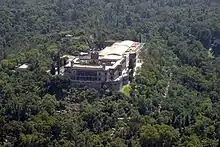Museo del Caracol
The Museo del Caracol (lit. Snail Museum) is a Mexican history museum, at the bottom of the access ramp to the Castillo de Chapultepec in Mexico City. The “Snail Museum” is a spiral shaped building designed by the architect Pedro Ramirez Vazquez. The director is Patricia Torres Aguilar Ugarte. It is opens from Tuesday to Thursday from 9:00 to 16:45.[1]

Building
Each of the exhibition halls are found around a central tower.
One of the most important pieces of the museum is the bronze handrail of the main stairs. It was made by the muralist José Chávez Morado and represents the fusion of two cultures (European and indigenous).[1][2]
To symbolize the colors of the Mexican flag, Chávez Morado covered with red tezontle the walls of the main tower, built the header of the constitution showcase with green marble, and placed white marble on the floor.[3]
Exhibitions

The museum is divided into five exhibitions.
The first is called the “Independence and first empire”. It is divided in four halls that are the final years of the viceroyalty, Miguel Hidalgo´s insurgency, Jose Maria Morelos participation, and the end of the Independence. The second one recounts the events of the “Republic and Northern Invasion”. This exhibition has two halls starting with how the First Mexican Republic is born and afterwards the Mexican–American War. The third exhibition is called “Reform and Restored Republic”. It has two main topics that includes the Reform War and the French Intervention. The fourth exhibition is called the “Porfiriato”. It shows the happenings during Diaz’s presidency. The last exhibition is called “Revolution”. It exhibits the main historical moments of the Mexican Revolution, the promulgation of the 1917 Mexican Constitution, and Mexico today.[4]

Depending on the exhibition hall, it may contain clay sculptures of Mexican characters and heroes, maps, paintings, flags, documents, portraits and photographs that portray Mexican history.[1][2]
A main characteristic of this museum is that it does not have any antique pieces. Instead, it has didactic exhibits such as models, portraits, maps and documents.[5]
The first part recreates scenes from Mexico with clay figures and scenographies made of wood and plastic. Each model has an audio and illumination system that plays narrations from the represented events. It includes the quotes from the main protagonists, as well as the music of that time. This improves the dramatics of the scenes. This museum portrays how common life in New Spain was during the late years of the viceroyalty, when the first conspiracies against the crown took place. The main events of the Independence War are explained as well as all the conspiracies from the criollo against the crown. It portrays the hard path that the country followed during the 19th century: interventionism, inside wars, territory loss. The contradictions of the Porfiriato are exposed such as the stability that provided the inequality in economy. The museum makes a special emphasis in Madero’s and all constitutionalists' roles in the Mexican Revolution.[3]
History
.jpg.webp)
Its construction was promoted by the professor Jaime Torres Bodet, who was secretary of public education. It opened in 1960 by the president Adolfo López Mateos, with the objective of teach the modern history of Mexico, from the independence war to the Mexican Revolution. It was constructed because of the 150th anniversary of the beginning of Independence and the 50th anniversary of the Revolution.[2]
A selected group of people participated on this project. The architect Pedro Ramirez Vazquez created a building that is in harmony with the Chapultepec hill. Iker Larrauri and Julio Prieto made the reconstruction of the scenes and the environment of the past. Ehe historian Arturo Arnaiz and Freg, elaborated the historical script.[5]
In only ten months the museum was ready. When it was inaugurated, the secretary Torres Bodet explained that the museum had an education function that would be like “an open textbook” so that people would find it easy to understand.[5]
References
- "Galería de Historia, Museo del Caracol". www.mexicoescultura.com. Retrieved 2015-11-20.
- "Cultura en México - museos - Sistema de Información Cultural - - CONACULTA". sic.conaculta.gob.mx. Retrieved 2015-11-20.
- "Galería de Historia, Museo del Caracol - Guía Turistica Chapultepec - México". www.chapultepec.com.mx. Retrieved 2015-11-20.
- "Bienvenido a la Galería de Historia, Museo del Caracol ¡Donde la Historia tiene vida!". CONACULTA.
- "Historia". CONACULTA.